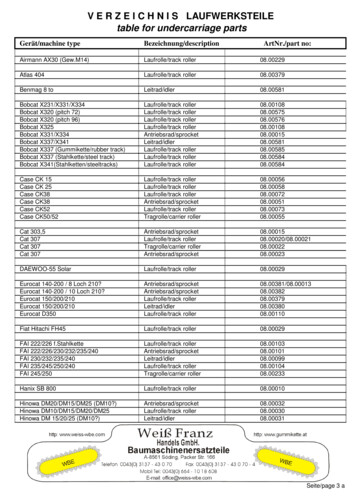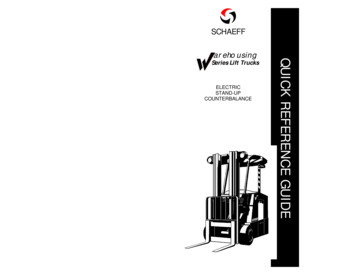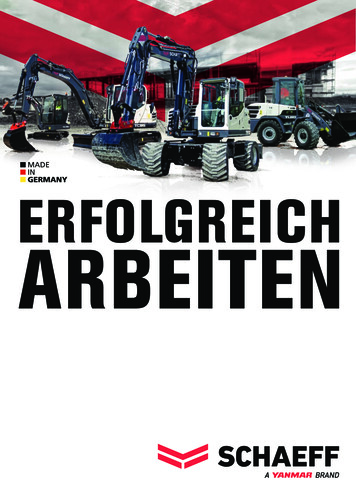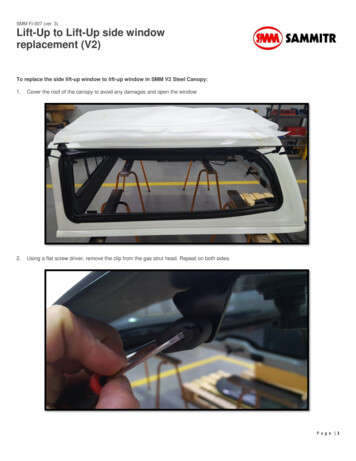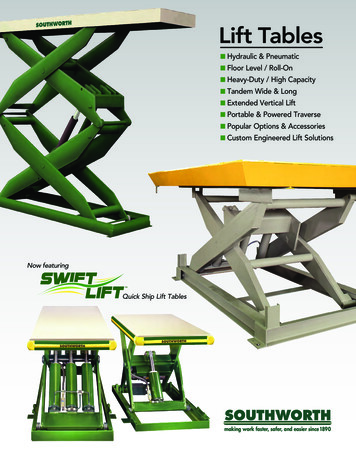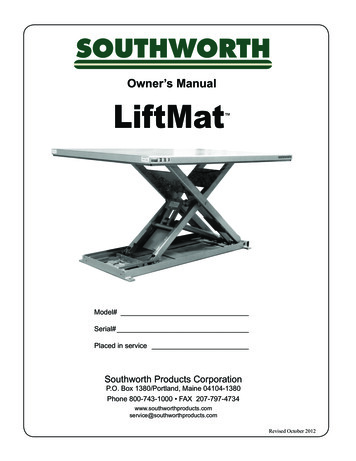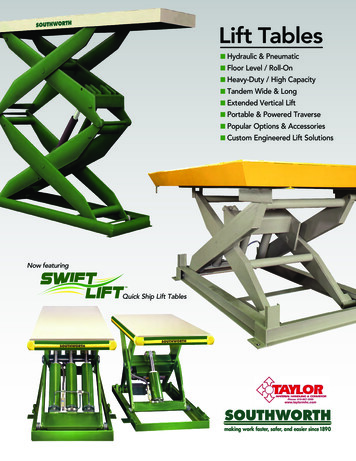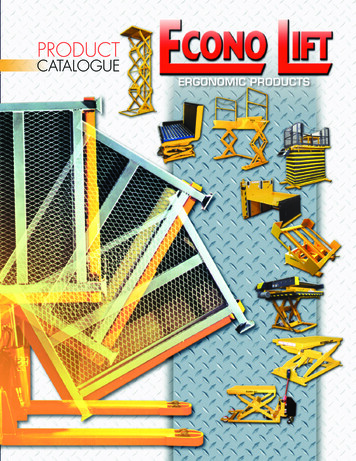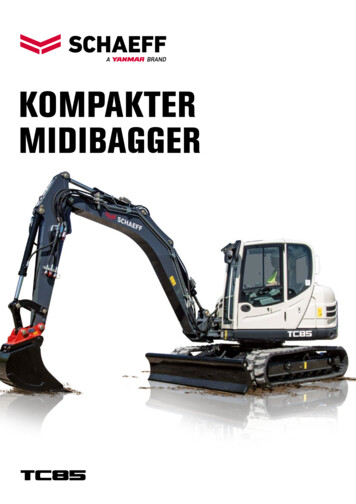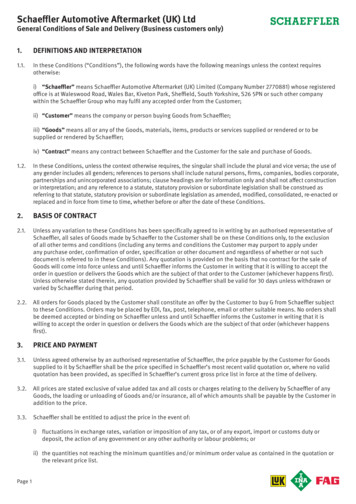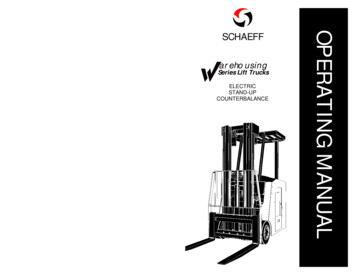
Transcription
SCHAEFFYour Schaeff dealer is:arehousingSeries Lift TrucksPhone Number: ( )Model:Serial Number:Date of Installation:Schaeff Inc. w P.O. Box 9700 w Sioux City, IA w 51102-9700712-944-5111 w Fax: 712-944-5115E-Mail: Mailbox@SchaeffInc.com w www.SchaeffInc.com Schaeff Inc. 7/97Part Number 6840001Printed in U.S.A.ELECTRICSTAND-UPCOUNTERBALANCEOPERATING MANUALSCHAEFFProviding VALUE Solutions
NotesWARNINGFailure to observe the following instructionscan cause the truck to tip, load to fall,serious injury or death.w Authorized, trained operator only.w Read Operating Manual before using.w Keep all portions of body inside the operator'scompartment while operating the truck.w When stopping, stay inside compartment until truckcomes to a complete stop.w Use caution when traveling.w Do not carry passengers.w Never load truck beyond its rated capacity.Read the entire contents of the Guide to Safe Operationsection of this Operating Manual for further safetyprecautions.This manual is not intended to be all encompassing and certainmaintenance procedures should be supplemented with theinformation contained in the Schaeff W-Series Service & PartsManual (6840003).
SCHAEFF OPERATING MANUALSCHAEFF OPERATING MANUALNotesTable of Contents38MESSAGE TO THE OPERATORThis manual is intended to aid you, the professional forklift operator, in theoperation of this forklift. It is intended as a permanent reference, and mustbe available for the operator to use at any time. If your forklift is notequipped with a copy of this manual, ask your supervisor to obtain one foryou.This manual describes necessary practices to maintain control of your forkliftand avoid accidents, injuries, and damage. It is not a substitute for anoperator training program. As a professional forklift operator, you areresponsible for being in control of your forklift at all times.While it may not be possible to prevent all accidents, following the guidelinesin this manual and being an alert operator who is in control of his/her forkliftand drives defensively, will greatly reduce the risk.You Must Be Trained . . . . . . . . . . . . .Not An Automobile . . . . . . . . . . . . . .General Description & Information . . .Operating Position . . . . . . . . . . . . . . .Operating Controls . . . . . . . . . . . . . . .Start-up Sequence . . . . . . . . . . . . . . .Traveling & Plugging . . . . . . . . . . . . .Steering.Lifting & Lowering . . . . . . . . . . . . . . .Tilting & Sideshifting . . . . . . . . . . . . . .Hydraulic Auxiliaries . . . . . . . . . . . . . .Optional Equipment . . . . . . . . . . . . . .Warnings & Errors . . . . . . . . . . . . . . .Inspections 20Stability and Capacity . . . . . . . . . . . . .Guide to Safe Operation . . . . . . . . . .Battery Care & Information . . . . . . . .Error Codes 33Maintenance Points . . . . . . . . . . . . . . .Scheduled Maintenance & InspectionsWarning Decals . . . . . . . . . . . . . . . . .i.ii1245810121416171819. . . . . . . . . . . . . . . . . . . . . . . . . . . 22. . . . . . . . . . . . . . . . . . . . . . . . . . . 25. . . . . . . . . . . . . . . . . . . . . . . . . . . 29. . . . . . . . . . . . . . . . . . . . . . . . . . . 34. . . . . . . . . . . . . . . . . . . . . . . . . . . 35. . . . . . . . . . . . . . . . . . . . . . . . . . . 36SCHAEFF INC.P.O. Box 9700Sioux City, IA 51102-9700 USAPhone (712) 944-5111Fax (712) 944-5115P/N 6841001 First Printing (June 15, 1999).
SCHAEFF OPERATING MANUALSCHAEFF OPERATING MANUALYou Must Be TrainedFederal law states that only trained and authorized operators are permitted tooperate a powered industrial truck and that your employer must trainoperators in the safe operation of powered industrial trucks. It is also theemployer's responsibility to make sure that the operator can see, hear, andhas the physical and mental ability to operate the equipment safely.(OSHA § 1910.178)Below are the warning decals located on your forklift. If any of these decalsbecome damaged or illegible, contact your authorized Schaeff dealer forreplacements. Remove the damaged decal, clean the area and apply thenew decal.1WARNING2DO NOT OPERATE THIS FORKLIFT UNTIL YOU HAVE BEENTRAINED AND AUTHORIZED BY YOUR EMPLOYER.YOU COULD BE KILLED OR SERIOUSLY INJURED IF YOU ARE NOTTRAINED TO OPERATE THIS FORKLIFT!BEFORE OPERATING THIS FORKLIFT:wYOU MUST SUCCESSFULLY COMPLETE A TRAINING ANDEVALUATION PROGRAM WHICH IS SPECIFIC TO THE TYPE OFTRUCK AND THE WORKPLACE.Schaeff offers operator training materials for this model forklift.wREAD THE ENTIRE OPERATING MANUALw Pay particular attention to the cautions and warnings, which areidentified throughout this manual as follows:w After studying this manual carefully, leave the manual with theWARNINGWARNING denotes a serioushazard which could cause injury ordeath to the operator or otherpersonnel.345CAUTION6CAUTION denotes a less serioushazard which could cause lessserious injury to the operator or otherpersonnel or damage to the forklift.7forklift for reference.wBECOME FAMILIAR WITH THE LOCATION AND FUNCTION OF ALLCONTROLSwREAD ALL SAFETY AND WARNING DECALS ON THE FORKLIFTw Warning decals and their locations are shown on Pages 36 & 3789ii37
SCHAEFF OPERATING MANUALSCHAEFF OPERATING MANUALWarning DecalsNot An AutomobileYour forklift is not an automobile. With a load, it may weighas much as three automobiles.w It does not drive like an automobile.w It does not steer like an automobile.w It does not brake like an automobile.942SPECIAL APPLICATIONS/SITUATIONSThis forklift should never be used for any functions other than thosedesignated for stand-up counterbalance lift trucks. This forklift is designed forindoor use and should not be exposed to outside weather conditions,including rain or snow, and is not intended for use on public roads.1Before placing this truck in a special application or situation, contactyour authorized SCHAEFF dealer for correct procedures76STANDARDS COMPLIANCEThis vehicle complies with American National Standards (ANSI) andOccupational Safety and Health Act (OSHA) regulations in effect at thedate of manufacture and is Underwriters Laboratory (UL) classified (seethe Serial ID Nameplate).Contact your authorized SCHAEFF dealer before making any alterationor modification to this vehicle.58If you should ever have any questions regarding training, or if yourforklift requires service, contact your authorized Schaeff dealer.3WARNING DECALS1. Operator Warning (7619118)2. Do Not Overload (7619119)3. Battery Connector (7619112)4. Overhead Guard (7619120)5.6.7.8.9.36Minimum Battery (7619123-X)Pinch Points (7619115)Mast Warning (7619113)Disconnect Battery (7619114)Moving Parts (7619117)1
Scheduled Maintenance & InspectionsSCHAEFF OPERATING MANUALSCHAEFF OPERATING MANUALGeneral Description & ON1BatteryCharge - NormalCharge - EqualizingCheck water level and cleanlinessConnector in good condition, bolt installed81XXCheck for free movement of the lever and that thelever disconnects the battery (Do not lubricate)X3Battery GatesCheck that they are securely in placeX4Battery RollersCheck that they are in place and battery cannot shiftX5BrakesReleased when brake pedal is depressed and stopsthe unit within the specified distance when pedal isreturned to up positionBrake pads - inspect and replace (as needed)Check for smooth operation, no binding, and thepedal comes up when foot is removedDo not lubricateXXX7Brake SwitchLocks out travel capability when pedal is upX8Carriage/LoadBackrest/ForksInspect for cracks, bends, and damageTorque lower plate bolts on Sideshift to 59 Lb-FtLubricate Sideshift Carriage as requiredX9Contactor TipsCheck condition, inspect for pitting, adequate tipcontact surface, signs of burning10Control HandleCheck for smooth and full movement forward,reverse, lift, and lower; check horn, tilt, and allauxiliary functions for operationDo not lubricateXCheck operational, safety, and warning decalsReplace if missing or unreadableX12GearboxCheck operationCheck fluid level and fill (as needed)Change fluidXCheck for leaksCheck level and fill (as needed)Change hydraulic oil and filterBreather cap - check and cleanX14Lift ChainsXCCCCXBBAAFGEHEHXXXCheck for wear,damage, and cotter pins in place onconnector pins at anchor boltsLubricate and adjustXX15LightsFunction when switched onX16MastInspect for damageCheck tilt cylinder mounting hardwareXX17Motor BrushesCheck for wear and proper seatingReplace (as needed)X18SteeringTurns without binding - no excess playX19Tires /WheelsInspect for cracks, gouges and wearLubricate wheel & final drive pinion bearingsLubricate final drive gearsXStatic strapIn place and touches the floorX20EXDecalsHydraulicSystemEX1113-40o F 32o F2000 toto360 32o F 120oFXBatteryDisconnectBrake Pedal/Brake Linkage35060X26405XXLUBRICATION REFERENCE TABLEATexaco 32 / Tellus 32 / Mobil DTE 24EMobilith SHC 220 Synthetic Grease NLGI 2 or equiv.BMcCollister Arctic Blue Hydraulic Oil 3028FSAE 20W Motor OilCMobil SHC 50 Synthetic Gear Lub. or equiv.GSAE 40W Motor OilHMobilith SHC 007 Synthetic Grease NLGI 00 or equiv.D235
SCHAEFF OPERATING MANUALSCHAEFF OPERATING MANUALMaintenance PointsYour Schaeff forklift is an electric, stand-up, counterbalanced materialhandling vehicle. It is driven by the front wheels and steered by the rearwheel. An industrial battery provides power.Your Schaeff forklift may be equipped with any or all of the following featureswhich make its operating characteristics different from other forklifts of thistype:wwwwwMulti-function control handle - see Page 6Electric Emergency / Parking Brakes - see Page 7Speed reduction in turns - see Page 13Lift Interrupt - see Page 15The following characteristics can be changed through the Program menu(ask your supervisor):Maximum Forward and Reverse SpeedsDrive Acceleration and Plugging RateTime delay before automatic power down if controls are not touchedYour forklift may have optional equipment installed which can change someoperating characteristics described in this manual.Make sure thenecessary instructions are available and understood before operatingthis forklift.All information, specifications and illustrations in this manual are based on thelatest available data at the time of publication. Schaeff is constantly strivingto improve its products and therefore reserves the right to change design,materials, and/or specifications without notice and without incurring obligationor liability.Correct operating positions are shown in the photos below.343
SCHAEFF OPERATING MANUALSCHAEFF OPERATING MANUALOperating PositionFault Codesw Step onto the forklift with your right foot first. Do not step on the brakepedal until you are completely inside the operator compartment. Do notmove the controls until you are completely inside the operatorcompartment.w On both forward and side stance models, grasp the control handle inyour right hand and the steering tiller in your left hand.w Always keep both feet in the operator compartment. Use only your leftfoot on the brake pedal.w Take advantage of the padding in the operator compartment.Some of the common fault codes are explained below. Some fault codes(such as E01 and E02) can be cleared without shutting the truck off. Otherfault codes (such as E05) require that the key switch be cycled.E01 - Release throttle to resume operation. You must return the controlhandle to neutral then step on the brake pedal before moving thecontrol handle into forward or reverse.E02 - Release control handle & step on brake to resume lifting. Brake-liftinterrupt is enabled. You must return the control handle to neutral thenstep on the brake pedal before moving the control handle into lift.Brake -lift interrupt can be disabled through programming.E05 - Battery voltage out of range. Make sure the battery is the correctvoltage for the truck (36V). The battery may be overcharged or mayhave a bad cell, etc.E15 - Reposition right foot to resume operation.properly positioned on the floorpad switch.Your right foot must beE61L/R - Left/Right motor brush wear failure. The brushes in the indicateddrive motor need to be replaced. Maximum speed is limited.E80 - Lift cutout due to low battery state of charge. The battery has beendischarged to the limit set in programming. The lift system has beendisabled. You must install a charged battery to resume operation.E82 - Engage brake to continue POST. Release the brake pedal to continuethe Power On Self Test.FORWARD STANCESIDE STANCE4OTHER FAULT CODES - Notify your supervisor and/or an authorizedservice technician if any OTHER FAULTCODES are displayed. A list of error codesand a description of each can be found on adecal on the underside of the top cover.33
SCHAEFF OPERATING MANUALSCHAEFF OPERATING MANUALBattery Care & Information cont'dOperating ControlsCHANGING THE BATTERYWARNINGBatteries are heavy and can cause serious injury. Use care to avoidinjury. DO NOT put hands, arms, feet, and/or legs between the batteryand a solid object. Make sure the battery is level when it is beingmoved.Your forklift is equipped with rollers in the battery compartment for ease ofremoval and installation of the battery.BEFORE REMOVING THE BATTERY:Ÿ Disconnect the cable and make sure it will not be damaged when thebattery is removed.Ÿ Remove the battery gate on one side of the forklift.BEFORE INSTALLING A BATTERY:Ÿ Make sure the key switch is OFF.Ÿ Ensure the battery gate on the opposite side is securely in place.Ÿ Make sure the battery is clean.Ÿ Make sure the battery is the correct voltage and amp-hour capacity.Ÿ Make sure the battery weight is within the specifications on the SIDNameplate (see Page 24).AFTER THE BATTERY IS INSTALLED:Ÿ The battery must not be able to slide more than 0.5" (13 mm) from side toside or front to back. If necessary, install shims to achieve thisspecification.Ÿ Ensure the machine screw and lock nut are installed in the batteryconnector. The emergency disconnect will not operate without them.Test the emergency disconnect after installation.325
SCHAEFF OPERATING MANUALSCHAEFF OPERATING MANUALTILT & SIDESHIFTBATTERY RECORD KEEPINGHORNIt is important to keep accurate records of your batteries. Battery failure cancause production slowdowns and increased battery operating costs. Bykeeping thorough records, irregularities can be spotted and corrected. Someof the problems to watch for when reviewing battery records are:TRAVEL FORKS FIRSTLOWERAUXILIARYwwwwwwUnder or overcharging.Over discharging.Excessive water consumption.Excessive dirt and corrosion.Worn-out batteries.Excessive current consumption by trucks.Your battery manufacturer can supply battery maintenance record forms tomake your record keeping more efficient. Each battery should have aseparate record, and each record should contain the following information:LIFTTRAVEL FORKS TRAILINGCONTROL HANDLEOPERATOR'S DISPLAY6wwwwwwwwwwwwBattery number, type, serial number, and service data.Specific gravity and voltage readings for each cell.Temperature of the air and electrolyte.Electrolyte.Amperes.Condition of connectors, covers, sealing compound, and tray.General cleanliness.Number of total cycles.Normal or equalizing charge.Average specific gravity drop.Watering frequency.Operator comments and observations.31
SCHAEFF OPERATING MANUALSCHAEFF OPERATING MANUALBattery Care & Information cont'dBATTERY INSPECTION AND CAREInspect the battery at least once a week. Make sure there are no looseconnections. Clean dust, dirt, and electrolyte from the battery by washing thebattery with a solution of baking soda and hot water. Use the followingprocedure:w Read, understand, and follow procedures, recommendations, andspecifications in the battery and battery charger manufacturer’s manuals.w Remove the battery from the lift truck.w Mix one pound of baking soda with 1 gallon hot water.w Tighten each vent cap (wear protective gloves).w Use a brush with flexible bristles to apply the baking soda solution to thetop of the battery. When fizzing stops, the acid has been neutralized.w Clean the top and sides of the battery and rinse the battery completely withclean water.w Vent plugs should be washed yearly or as needed, and the gas-escapeholes should be inspected to ensure they are not plugged with dirt.EMERGENCY DISCONNECT LEVERPush the disconnect lever toward the forks to mechanicallyseparate the battery connectors and shut off all power (thekey switch does not cut all power to the forklift). Toreconnect the battery, align the mating halves of theconnectors and push them together.CAUTIONA cap screw and lock nut must be correctly fastenedto the battery connector for the emergency disconnectlever to operate correctly.Make sure this screw isinstalled in battery connector.If the battery is being tested for a specific problem, it is recommended thatthe battery be cleaned before testing.NOTEWet covers can be an indication of overfilling, leaky seals at posts, orexcessive gassing during charging. When observed, contact servicepersonnel.BATTERY TESTING, CHARGING, & MAINTENANCEDO NOT plug a battery charger into the liftCAUTIONLead fromBatteryBRAKE PEDALw Step all the way down on the pedal to release thebrakes and enable the drive system.w Let the brake pedal rise to apply the brakes. As soonas the pedal starts to lift, power is cut to the drivemotors. DO NOT use the brake pedal as the servicebrake.truck. This will severely damage the lifttruck’s electrical system.For information on testing, charging, and maintaining your lift truck battery,consult your battery manufacturer’s specifications and instruction manual.WARNINGwww30NEVER use two feet on the brake pedal.Release the brake pedal only in an emergency.The forklift will stop abruptly which may cause theload to fall.Always travel at a speed which will allow you tostop in a safe manner.7
SCHAEFF OPERATING MANUALSCHAEFF OPERATING MANUALBattery Care & InformationStart-up SequenceDO NOT OPERATE THIS FORKLIFT UNLESS:STOPþ YOU HAVE BEEN TRAINED AND AUTHORIZEDþ YOU HAVE READ AND UNDERSTAND THISENTIRE MANUALþ YOU KNOW THE CAPACITY (WEIGHT AT LOADCENTER AND LIFT HEIGHT) OF THIS FORKLIFTþ YOU HAVE COMPLETED THE PRE-OPERATIONALINSPECTIONS (PAGE 20)Read and follow the instructions supplied with the battery used in your forklift.If anything regarding the use or maintenance of the battery is unclear, contactthe battery supplier for complete information.Battery care is important to the use of the forklift. The useful life of thebattery can be lengthened by following a scheduled maintenance program.The information in this section does not replace the instructions supplied bythe battery manufacturer.WARNINGNOTEIf the Start-up Sequence is not followed correctly, thetruck will not run, and an error code may be displayed.Some codes alert the operator to change his actions,others relate to truck service issues. See Page 33 for adescription of the operator-induced errors.1. Step into the operator compartment. DO NOT step onthe brake pedal or move the control handle at this time.Keep all parts of your body inside the operatorcompartment at all times.2. Turn the key clockwise to the "I" position. At this point,the LED Display will show the Battery State-of-Charge:b-82Other information can be viewed by pressing tiltforward or tilt backward on the control handle. Thisinformation includes: Hour Meter (hours), SerialNumber (ser n), and Software Version (code). ThePerf selection is used to access the Performance andDiagnostics Menu (refer to the Quick ReferenceGuide).3. Turn the key clockwise to the "II" position and releaseit (like starting an automobile).8For your safety, observe the following precautions when working withor around lift truck batteries:Ÿ Read, understand, and follow procedures, recommendations, andspecifications in the battery and battery charger manufacturer’smanuals.Ÿ Always wear proper protective clothing including eye, face, and skinprotection. Make sure and eye wash station is nearby.Ÿ DO NOT smoke or use spark-producing devices near the battery.Ÿ DO NOT expose the battery to open flames.Ÿ Always charge batteries in a well-ventilated area to avoid hydrogengas concentration.Ÿ Clean batteries regularly; corrosion causes grounds and thepossibility of sparks.Ÿ Keep plugs, terminals, cables, and receptacles in good condition toavoid shorts and sparks.Ÿ Charge batteries at the indicated rates.Ÿ DO NOT lay tools, chains, or other metal objects on top of thebattery.Ÿ DO NOT overcharge batteries.Ÿ DO NOT connect the battery charger plug to the lift truck.Ÿ Ensure charger voltage is correct for the batteries being charged.29
SCHAEFF OPERATING MANUALSCHAEFF OPERATING MANUALGuide to Safe Operationcont'd4. Wait for the self-test to finish. NOTE: the brake pedalmust be up (brakes engaged) and the control handle inneutral during the self-test. If the brake pedal is not upduring POST, fault code E82 will be displayed.If a problem is detected during POST, a fault codewill appear in the LED Display (Fault Codedescriptions can be found on the underside ofthe top cover). Notify your supervisor ifanything is wrong with the forklift.If the control system finds no problems, the LEDDisplay will say on . The forklift is ready tooperate. If fault codes E01 or E02 are displayed,you must return the control handle to neutral andstep on the brake pedal to resume operation.AVOID FALLS AND TIPOVERSŸŸŸŸŸŸŸŸForklift tipover can cause serious injury or death ifyou are trapped between the forklift and theground.Maintain a safe distance from the edge of docks,ramps, and other elevated working surfaces.Make sure a highway truck or trailer cannot roll orbe driven away from the dock during loading andunloading by using wheel chocks or an approveddock locking device.Avoid bumps, holes, slick spots and loosematerials that may cause the forklift to swerve ortip.Always keep the load upgrade when traveling on aramp or other slope, and never turn on or driveacross a ramp or slope.DO NOT use aggressive braking or acceleration,especially with an elevated load.Keep the mast vertical when the load is raised. Excessive forward tilt cancause the forklift to tip over.While there is no sure way, in all circumstances, to avoid injury during atipover or a drop from a dock or dock board, you should be aware of thefollowing recommendations in accordance with ITA:- If you can safely get completely clear, you should step off and awayfrom the falling or tipping forklift.- In the event of an imminent collision, you should stay within theoperator compartment.- Ask your supervisor about special precautions or operatinginstructions for your workplace.þ PERFORM THE OPERATIONAL INSPECTIONS (SEEPAGE 21)5. You may now operate the forklift.WHEN YOU LEAVE THE FORKLIFT, TURN THE KEY TO THE "0"POSITION TO SHUT THE FORKLIFT OFF. REMOVE THE KEY.BATTERY STATE OF CHARGE INDICATORThis indicator (on the Operator's Display, Page 6) showsthe percentage of charge remaining in the battery before liftcutout occurs. Each of the LEDs represent 10% of theremaining charge. When less than 5% remains before liftcutout, the last LED will start to flash slowly, changing to afast flash when it drops below 2%. When the battery isdischarged to the lift cutout point, all LEDs will be off.PARKING YOUR FORKLIFTŸŸŸŸŸWait for the forklift to come to a complete stop before getting off.Lower the forks to the floor.Turn the key switch to the "0" (Off) position. Remove the key anddisconnect the battery.Avoid parking on inclines. If you must leave the forklift on an incline, putblocks on the downhill side of the wheels.DO NOT park the forklift so that it limits access to fire aisles, stairways,and fire equipment.28LED DISPLAYDuring operation the LED Display can present the followinginformation:e01FAULTS - if a problem is detected, the fault code willappear on the LED Display (see Fault Codes on Page33 or the Fault Code decal under the top cover).9
SCHAEFF OPERATING MANUALSCHAEFF OPERATING MANUALTraveling & PluggingLIFT AND LOAD CAREFULLYŸTRAVELw Move the control handle toward the forks to travel forks first.w Move the control handle away from the forks to travel with forks trailing.w The farther you move the handle from neutral, the faster the forklift willtravel.w Read the Guide to Safe Operation (Pages 25 - 28) before operating thisforklift.ŸŸŸŸHandle only loads within the capacity of your forklift as shown on thenameplate.Handle only stable loads. Do not handle a load if any loose part of it isabove the load backrest or any part of the load is likely to fall.Position each fork the same distance from the center of the carriage. Setthe forks as far apart as possible for maximum support of the load.Center the weight of the load between the forks. Make sure the pins thatkeep the forks in position are engaged so that the forks cannot move.Be careful of forks that extend past the load so that materials orequipment that are behind are not damaged.Lift and lower with the mast vertical or tilted slightly backward fromvertical. Tilt elevated loads forward only when directly over the unloadingplace. If the mast is raised to pick up or deposit a load, keep the tilt anglein either direction to a minimum.RAMP, SLOPE, OR GRADE OPERATIONwwwwwww10While carrying a load, the load should be upgrade when ascending ordescending.If the vehicle is empty (no load on forks), the forks should be downgradewhen ascending or descending.Lift the load just enough to clear the ramp.Ensure the forklift is square with the ramp before ascending ordescending.DO NOT turn on a ramp, slope, or grade - side tipover can occur.DO NOT drive across a ramp, slope, or grade -- side tipover can occur.DO NOT operate on a ramp with a grade of more than 15 percent.27
SCHAEFF OPERATING MANUALSCHAEFF OPERATING MANUALGuide to Safe Operationcont'dBE AWARE OF OTHER PEOPLEŸŸŸŸŸŸWatch out for pedestrians at all times. DO NOT drive up close to anyonestanding in front of an object. Use extra care at cross aisles, doorways,and other locations where pedestrians can step into the path of travel ofthe forklift. Slow down when approaching blind intersections or turns.Sound the horn to warn pedestrians that there is a vehicle in the area andto be alert to possible danger.No Riders. A forklift is built for only one person, the operator. It isdangerous for anyone to ride on the forks or anywhere else on the forklift.Never lift anyone on the forks unless they are using an approved safetyplatform. Even then use extreme caution.Do not allow anyone on or under the load or forks.Keep hands and arms clear of the mast.Don't let anyone use your forklift unless he or she is trained andauthorized.PLUGGINGw To slow down or stop, move the control handle in the direction opposite oftravel. Slowing by reversing direction is called plugging and will notdamage the drive system.w The brakes are designed to stop the forklift in a shorter distance thanplugging. Release the brake pedal to stop in an emergency.WARNINGPlugging works only when the brake pedal is all the way down. Whenthe brake pedal begins to lift, power is cut to the drive system and youwill not be able to use plugging.CAUTIONThe forklift will roll freely when the control handle is in neutral and thebrake pedal is down. You must use plugging to slow down or stop, orlift your left foot from the brake pedal to stop in an emergency.DRIVE CAREFULLYŸŸŸŸŸŸŸŸŸAnytime the forklift is moving keep your arms, legs, etc., inside theoperator compartment. Arms and legs outside the forklift can be crushedor cut off when passing obstructions.Observe traffic rules and be in full control of the forklift at all times.Always look in the direction of travel. Normally, direction of travel isdetermined by the best visibility available to you. If you must travel in adirection where visibility is obstructed, a lookout or helper may berequired.Watch clearances, especially forks, mast, overhead guard, and tailswing.DO NOT indulge in stunt driving or horseplay.DO NOT pass another vehicle traveling in the same direction atintersections, blind spots, or at other dangerous locations.Under all travel conditions, operate the forklift at a speed that will permit itto be brought to a stop in a safe manner.Avoid fast starts and stops. Sudden movement can cause the forklift totip or the load to fall.Always travel with the load as low as possible and tilted backward. Keepthe load against the carriage.26HORNSound the horn to warn pedestrians andother drivers of your presence. Use it atintersections and crosswalks.11
SCHAEFF OPERATING MANUALSCHAEFF OPERATING MANUALGuide to Safe OperationSteeringYour forklift may be equipped with standard or reverse steering. Either way, itdoes not steer like an automobile. Drive slowly until you get used to thesteering and all other controls.WARNINGFAILURE TO OBSERVE THE FOLLOWING INSTRUCTIONS CAN CAUSETHE FORKLIFT TO TIP, LOAD TO FALL, SERIOUS INJURY OR DEATH.AUTHORIZED AND TRAINED OPERATOR ONLYŸŸŸŸShows direction forkliftwill turn when tiller isturned clockwise.ŸŸYou must be trained and authorized to use this forklift.Read the entire Operating Manual before operating this forklift.You must know the capacity (weight, load center, and lift height) of yourforklift. This information is on the Serial Nameplate. DO NOT exceedthe capacity of your forklift.Know the weight of your forklift. This information is on the SerialNameplate. Dockboards, elevators, and some floors have limitedcapacity.Know the operating instructions of any attachments and use theattachments for the intended purpose only.Know the type of your forklift. This information is fou
Your Schaeff forklift is an electric,stand-up, counterbalanced material handling vehicle. It is driven by the front wheels and steered by the rear wheel. An industrial battery provides power. Your Schaeff forklift may be equipped with any or all of the following features which make its operating characteristics different from other forklifts of this type:
